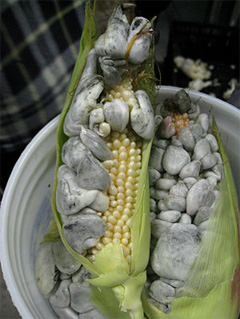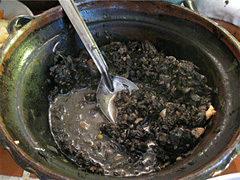
|  |  |  Entertainment | Restaurants & Dining | August 2009 Entertainment | Restaurants & Dining | August 2009  
In Mexico, Tar-Like Fungus Considered Delicacy
 Monica Ortiz Uribe - NPR Monica Ortiz Uribe - NPR
go to original
August 20, 2009


| | Cuitlacoche grows when a drop of rain seeps into a husk of corn. The moisture rots between the kernels and produces the fungus, which can grow over or side by side with the kernels. (Monica Ortiz Uribe/NPR) | 
| | When cooked, cuitlacoche turns into a tar-like mush that is popularly used in quesadillas. Cuitlacoche is typically prepared with the Mexican herb epazote, onion and chili pepper. (Monica Ortiz Uribe/NPR) |  |
In Central Mexico, locals are feasting on a unique delicacy that sprouts to life this time of year from the country's corn fields.

It's still called by its Aztec name, cuitlacoche (pronounced QUEET-la-coh-chay). The gray, stone-shaped fungus turns into a gunky, tar-like mush when cooked.

But it is revered by Mexican gourmet chefs and home-style cooks alike. The fungus is a popular ingredient in soups and quesadillas.

Farmers hunt for cuitlacoche during the rainy season from now through mid-October.

Sometimes the farmers call the dish "el oro negro," or black gold.

In a corn field two hours south of Mexico City, farmer Ezequiel Salinas Ramon looks for cuitlacoche in an endless field of tall cornstalks.

The fungus grows inside corn husks. Cuitlacoche flourishes when droplets of rain seep into a stalk of corn and the kernels begin to rot.

Salinas, 59, who has been farming the fungus since he was a child, wades through 40 or more stalks of corn before he finds something.

"We're in luck! We've found one. Here it is," he shouts when he discovers an infested stalk.

The fungus is collected in big buckets. A pound of cuitlacoche can fetch as much as $3 on the market.

Renowned Mexico City chef Carmen Ramirez Degollado says foreigners have a lot to learn about Mexican food. She prepares her cuitlacoche simply, with the Mexican herb epazote, onion and chili pepper.

"We have a very fine Mexican cuisine. It's not all about tacos," she says.

Businesswoman Ruth Martinez recently dined on a dish of chicken-stuffed cuitlacoche at a Mexico City restaurant.

When asked to describe how it tastes, Martinez evokes a popular song by Latino singer Enrique Iglesias.

"It's a religious experience," she says.

Not a bad compliment for a fungus that in other parts of the world is simply thrown away. |

 |
|  |



